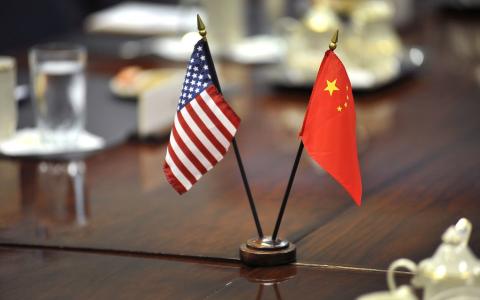
(Reuters) An ambitious “phase two” trade deal between the United States and China is looking less likely as the two countries struggle to strike a preliminary “phase one” agreement, according to U.S. and Beijing officials, lawmakers and trade experts.
In October, U.S. President Donald Trump said during a press conference with Chinese vice premier Liu He that he expected to quickly dive into a second phase of talks once “phase one” had been completed. The second phase would focus on a key U.S. complaint that China effectively steals U.S. intellectual property by forcing U.S. companies to transfer their technology to Chinese rivals, he said at the time.
But the November 2020 U.S. presidential election, the difficulties in getting the first-stage done, combined with the White House’s reluctance to work with other countries to pressure Beijing are dimming hopes for anything more ambitious in the near future, the sources said.
The 16-month trade war with China has thrown U.S. businesses and farmers into turmoil, disrupted global supply chains and been a drag on economies worldwide. Failure to address a key reason it was started is already raising questions about whether the sacrifice has been worth it. Meanwhile, many of Beijing’s trade practices that many free-market economies see as unfair remain unaddressed.
Reuters reported on Wednesday that the signing of a phase one deal could slide into next year as the two countries tussle over Beijing’s demand for more extensive tariff rollbacks.
Officials in Beijing say they don’t anticipate sitting down to discuss a phase two deal before the U.S. election, in part because they want to wait to see if Trump wins a second term.
“It’s Trump who wants to sign these deals, not us. We can wait,” one Chinese official told Reuters.
Representative Jim Costa, a California Democrat who sits on two key agricultural committees, said in Congress on Wednesday that “pragmatic” Chinese sources had told him the same thing.
Trump’s main priority at the moment is to secure a big phase one announcement, locking in big-ticket Chinese purchases of U.S. agricultural goods that he can tout as an important win during his re-election campaign, according to a Trump administration official.
After that, China could recede somewhat on Trump’s policy agenda as he turns to domestic issues, the official said, speaking on condition of anonymity. He will probably leave other major contentious issues to senior aides, who are likely to continue pushing Beijing over the theft of U.S. intellectual property, its militarization of the South China Sea and its human rights record, the official said.
“As soon as we finish phase one we’re going to start negotiating phase two,” a second administration official said. “As far as timing around when a phase two deal could be completed, that’s not something I can speculate on.”
THE HARD STUFF
The Trump White House initially laid out ambitious plans to restructure the United States’ relationship with China, including addressing what a 2018 United States Trade Representative investigation concluded were Beijing’s “unfair, unreasonable, and market-distorting practices.”
There is broad bipartisan support for Trump’s drive to hold China accountable for years of economic espionage, cyber attacks, forced technology transfer and dumping of low-priced goods made with hefty government subsidies.
But many of these critical concerns will not be addressed in the phase one agreement, which focuses on China agricultural product buys, tariff roll backs, and includes some intellectual property pledges.
“That’s the easy stuff,” said Costa. The harder issues are “industrial espionage, copyrights, complying with those issues, privacy and security issues.”
Further complicating the issue, Trump’s economic advisers are split: some are pushing Trump to agree to a quick phase one deal to appease markets and business executives, others want him to push for a more comprehensive agreement.
Beijing officials, meanwhile, are balking at pursuing larger structural changes to managing China’s economy, anxious not to appear to be kowtowing to U.S. interests.
Both China and the United States have a clear interest in getting a phase one deal completed relatively soon to soothe markets and assuage domestic policy concerns, said Matthew Goodman, a former U.S. government official and trade expert at the Center for Strategic and International Studies.
He sees a good chance that the two sides will hammer out some phase one deal, but is far less convinced that a broader deal can be reached before the election. One key problem, he said, was the continued lack of a coherent U.S. strategy for dealing with China.
“I think phase one probably will happen because both presidents want it,” Goodman said at a Congressional briefing last week. But he said China was less willing now to make structural changes that might have been possible in the spring. “They’re not going to do those things,” he said.
Josh Kallmer, a former official with the U.S. Trade Representative’s office and now executive vice president of the Information Technology Industry Council, said it was “technically possible, but hard to imagine” that the United States and Beijing could negotiate a phase two deal in the next year.
The United States needs better coordination with its allies to pressure China to make urgently needed structural changes, including ending the forced transfer of technology and better intellectual property protections, trade experts and former officials say.
Europe and other U.S. allies have been reluctant to join Washington’s pressure campaign on Beijing, partly due to frustration with the administration’s focus on unilateral action and in part due to their reliance on Chinese investment.
“We need an international coalition to successfully attack phase two,” said Kellie Meiman Hock, managing partner at McLarty Associates, a trade consulting group in Washington.



